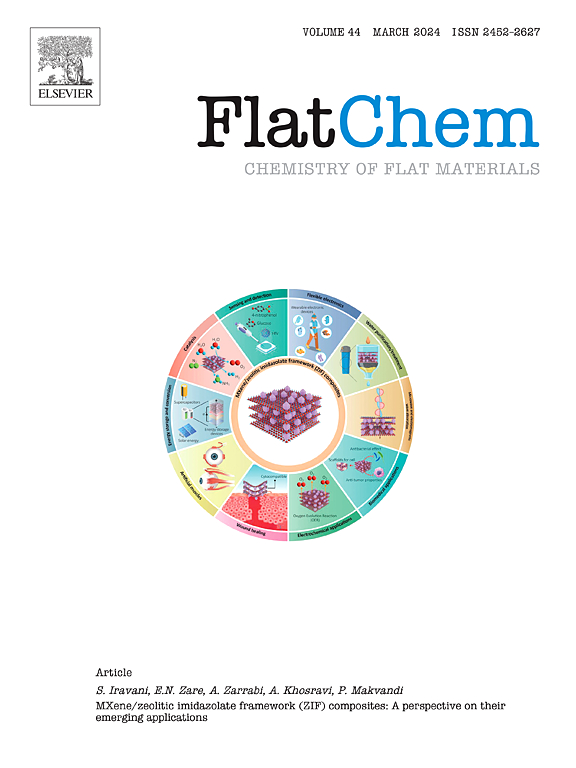Efficient electrochemical synthesis of 2H-MoS2/S-Doped graphene oxide composites for Binder-Free High-Performance supercapacitor electrodes
IF 6.2
3区 材料科学
Q2 CHEMISTRY, PHYSICAL
引用次数: 0
Abstract
The objective of this research is to examine the synthesis and characterization of molybdenum disulfide (MoS2) and sulphur-doped graphene oxide (S-GO) composites as potential materials for advanced supercapacitors. The study reports the first use of 2H-MoS2@SG-based materials, synthesized via an electrochemical method at room temperature, as binder-free electrode materials in supercapacitors. The synthesis of 2H-MoS2 involved cyclic voltammetry (CV), while sulfur-doped graphene oxide (SGO) was synthesized using chronoamperometry (CA). The materials were comprehensively characterized using various techniques, including Raman spectroscopy, X-ray photoelectron spectroscopy, and X-ray diffraction (XRD), to gain insights into their chemical structure. The surface morphology of the composites was examined using scanning electron microscopy (SEM) coupled with energy-dispersive X-ray spectroscopy (EDX). Additionally, the capacitive behavior changes over numerous cycles were evaluated through cyclic voltammetry, electrochemical impedance spectroscopy, and cyclic charge/discharge tests. The highest specific capacitance achieved was 532.8 mF cm−2 at 10 mA cm−2 (266.4F/g at 0.5 A g−1 current density) with the 2H-MoS2@SG electrode and 247.4 mF cm−2 at 10 mA cm−2 (190.31F/g at 0.5 A g−1 current density) with the SG10 electrode. These values were measured at charge–discharge current rates of 10 mAcm−2 in a 1.0 M H2SO4 electrolyte. Moreover, the capacitive behavior of this electrode was tested over 5000 cycles, showing a capacitance retention of more than 99.2 % at the end of the 5000 cycles. 2H-MoS2@SG electrodes shows a high coulombic efficiency of 100 % over 5000 cycles at 0.5 A g−1.

高效电化学合成用于无粘结剂高性能超级电容器电极的 2H-MoS2/S 掺杂氧化石墨烯复合材料
本研究的目的是研究二硫化钼(MoS2)和硫掺杂氧化石墨烯(S-GO)复合材料作为先进超级电容器的潜在材料的合成和表征。该研究报告首次使用2H-MoS2@SG-based材料,通过电化学方法在室温下合成,作为超级电容器的无粘结剂电极材料。2H-MoS2的合成采用循环伏安法(CV),而硫掺杂氧化石墨烯(SGO)的合成采用计时安培法(CA)。利用拉曼光谱、x射线光电子能谱和x射线衍射(XRD)等多种技术对材料进行了全面表征,以深入了解其化学结构。利用扫描电子显微镜(SEM)和能量色散x射线能谱(EDX)对复合材料的表面形貌进行了表征。此外,通过循环伏安法、电化学阻抗谱和循环充放电测试,评估了多次循环后的电容行为变化。2H-MoS2@SG电极在10 mA cm−2 (0.5 A g−1电流密度为266.4F/g)时获得的最高比电容为532.8 mF cm−2,SG10电极在10 mA cm−2 (190.31F/g, 0.5 A g−1电流密度)时获得的最高比电容为247.4 mF cm−2。这些值是在1.0 M H2SO4电解质中以10 mAcm−2的充放电电流速率测量的。此外,对该电极的电容性能进行了5000次循环测试,在5000次循环结束时,电容保持率超过99.2%。2H-MoS2@SG电极在0.5 a g−1下,在5000次循环中显示出100%的高库仑效率。
本文章由计算机程序翻译,如有差异,请以英文原文为准。
求助全文
约1分钟内获得全文
求助全文
来源期刊

FlatChem
Multiple-
CiteScore
8.40
自引率
6.50%
发文量
104
审稿时长
26 days
期刊介绍:
FlatChem - Chemistry of Flat Materials, a new voice in the community, publishes original and significant, cutting-edge research related to the chemistry of graphene and related 2D & layered materials. The overall aim of the journal is to combine the chemistry and applications of these materials, where the submission of communications, full papers, and concepts should contain chemistry in a materials context, which can be both experimental and/or theoretical. In addition to original research articles, FlatChem also offers reviews, minireviews, highlights and perspectives on the future of this research area with the scientific leaders in fields related to Flat Materials. Topics of interest include, but are not limited to, the following: -Design, synthesis, applications and investigation of graphene, graphene related materials and other 2D & layered materials (for example Silicene, Germanene, Phosphorene, MXenes, Boron nitride, Transition metal dichalcogenides) -Characterization of these materials using all forms of spectroscopy and microscopy techniques -Chemical modification or functionalization and dispersion of these materials, as well as interactions with other materials -Exploring the surface chemistry of these materials for applications in: Sensors or detectors in electrochemical/Lab on a Chip devices, Composite materials, Membranes, Environment technology, Catalysis for energy storage and conversion (for example fuel cells, supercapacitors, batteries, hydrogen storage), Biomedical technology (drug delivery, biosensing, bioimaging)
 求助内容:
求助内容: 应助结果提醒方式:
应助结果提醒方式:


